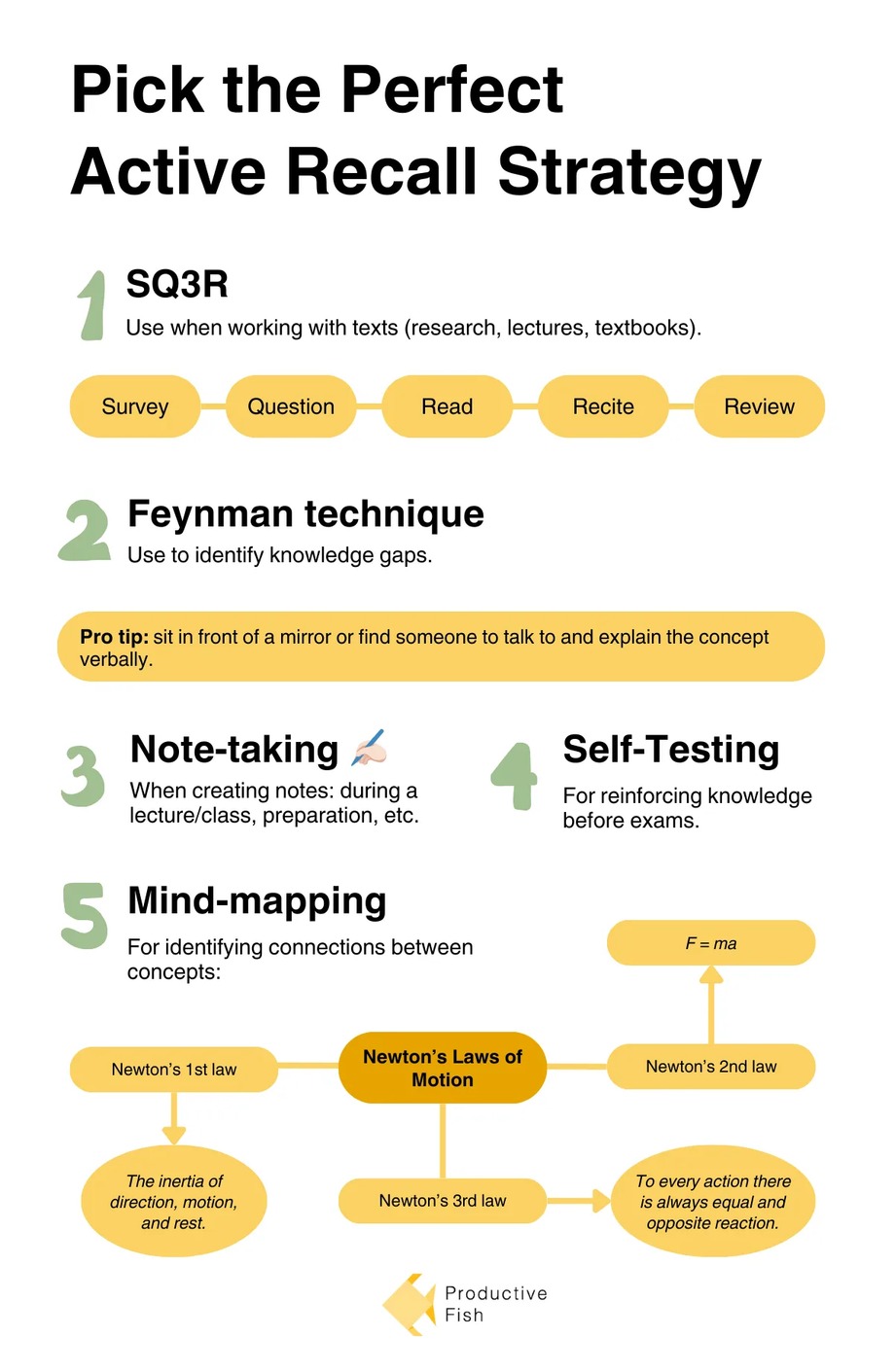Guide to Applying Active Recall Techniques
Updated on 12 Mar 2024 • 7 min read • posted by Maria H
Preparing for exams or tests can be an overwhelming experience. How many times have you spent hours reading a textbook and then found yourself unable to recall a single thing from it? It's a frustrating scenario that can happen more times than you realize. However, there is a proven method to help you overcome this problem and improve your overall academic performance.

So let's learn more about the method of active recall, which can significantly improve your ability to memorize and understand the material you are studying. We will discuss the scientific basis of this method, highlight its benefits, and provide you with practical strategies to apply it effectively.
What is Active Recall
Active recall is a study method that goes beyond simply reading and passively absorbing information. It involves actively retrieving and recalling information from memory, challenging yourself to remember key concepts, facts, details, etc. By recalling information, you promote deep understanding, long-term retention, and the ability to apply knowledge in practical situations. Unlike passive learning methods that rely on repetition or re-reading, active recall forces your brain to actively retrieve information, reinforcing the connections between different pieces of knowledge and facilitating more efficient learning.
How Does the Active Recall Method Work
Active recall works by tapping into our brain's amazing cognitive processes that help us learn and remember information. When we passively read something, like a textbook or an article, our brain's response is quite different compared to when we actively recall the information.
Imagine you're reading a chapter in a book. Your brain's main area involved in memory, called the hippocampus, is activated as you take in the information. However, this activation is relatively short-lived and doesn't lead to strong connections in your brain.
Now, let's switch to the active recall study method. Instead of just reading, you actively engage with the material by retrieving and recalling information from memory. The hippocampus gets more active, and it starts making stronger connections with the information you're recalling. These connections help your brain store and retrieve information more effectively.
In a nutshell, the active recall method takes advantage of two important things: retrieval practice and the testing effect. Retrieval practice means actively recalling information, which strengthens your memory connections. The testing effect refers to the idea that testing yourself on what you've learned improves your long-term memory much more than simply re-reading or reviewing. Think of it like exercising your brain. When you recall the information, you're giving your memory a workout, like doing push-ups for your brain, which makes it stronger and more efficient.
Science Behind Active Recall
In 2013 members of the Association for Psychological Since rated practice testing as highly valued based on evidence from a wide range of formats, materials, learner ages, outcome measures, and retention intervals. The study emphasized the broad applicability of practice testing in enhancing learning outcomes.
Notably, Jeffrey D. Karpicke and Janell R. Blunt described the study from 2011 when students were divided into four groups, each tasked with learning the same material and subsequently being tested on their knowledge. Here are the results for each group:
- Group 1: read the material only once.
- Group 2: read the material four times.
- Group 3: read the material and create a mind map.
- Group 4: read the material once, then recall as much as possible.
The study results showed that in both the verbatim test, which assessed factual recall, and the inference test, which assessed conceptual understanding, the group that engaged in active recall significantly outperformed the other groups. The active recall group demonstrated superior performance compared to those who read the material multiple times or created a mind map.
This study highlights the powerful impact of active recall. Testing oneself just once, instead of relying on repetitive reading, can lead to significantly better learning outcomes. It's a simple yet effective technique that can drastically improve the efficiency and efficacy of your studies. Take advantage of this straightforward approach and unlock your true learning potential!
How to Use Active Recall
The key idea of active recall method is to engage with the material. There are six active recall study methods to apply while studying. Let's learn how to do active recall:
SQ3R Method
The SQ3R method is a study technique that helps you understand and remember what you read more effectively. It's called SQ3R because it stands for five steps: Survey, Question, Read, Recite, and Review. Here's a video that breaks down each step: “What is SQ3R Method and How to Use It?”.
Feynman Technique
Explain the concepts you learned as if you were teaching them to someone else. In other words – use the Feynman technique. Simplify complex ideas and break them down into understandable explanations. Identify any areas where your understanding falters and revise accordingly.
Flashcards
Convert key concepts, definitions, and important facts into flashcards. Write the question or concept on one side and the answer on the other. Review the flashcards regularly, testing your memory and actively recalling the information.
Research conducted by Roediger and Karpicke in 2006, published in the Journal of Experimental Psychology, demonstrated the effectiveness of flashcards in promoting long-term retention. Their study showed that regularly testing oneself using flashcards led to better learning outcomes compared to simple rereading or summarization.
Active Note-Taking
Actively engage with the material by using a suitable for you note-taking method and organizing the information. Instead of transcribing everything, focus on capturing the main ideas, key concepts, and supporting details. Use abbreviations, symbols, and your own words to summarize and condense the information.
Organize your class notes, handouts, and other relevant materials into meaningful groups or categories. Use toggles, labels, or color-coding to create a visual structure that aids in recalling and reviewing information.
Mind-Mapping
Transform your notes into visual representations such as mind maps or schemes. Capture the main topics, subtopics, and their interconnections using diagrams, arrows, and keywords. Visualizing the material enhances comprehension and promotes effective recall.
Self-Testing
Set up regular self-testing sessions to gauge your knowledge and recall of the material. Use a variety of question formats, such as multiple-choice, fill-in-the-blanks, or essay-style questions. Actively retrieve the information from your memory, reinforcing connections and solidifying your learning.
To make things easier - we've created the active recall infographic that'll help you to choose the method.

Tips to Apply with Active Recall
To maximize your learning and optimize your performance, it's essential to embrace a comprehensive approach of active recall studying method at different stages of your learning.
Before Class
Using the active recall method before attending a class or lecture can help you make the most out of your learning experience. Here are some effective methods to incorporate it into your pre-class routine:
Review old notes. Take a few minutes to review any previous notes or materials related to the upcoming class. Scan through the key points, main concepts, and important details. Summarize the information without relying heavily on the notes.
Recite information. Explain aloud the key concepts, definitions, or formulas. Verbalizing the information helps reinforce your memory and understanding of the material. Practice recalling the information in your own words to ensure comprehension.
Quickly review the topic and sources. Skim through the assigned readings, textbook chapters, or other relevant sources related to the topic. Pay attention to headings, subheadings, and summaries to quickly grasp the main ideas and key details. Try to recall and connect the main points from the different sources.
During the Class
Enhance your understanding and retention of the material as the class is going. Here are tips to employ:
Take in-class questions. As the instructor presents the material, actively generate questions related to the content. Challenge yourself to recall key information and think critically about the topic. Jot down these questions to revisit later for self-testing and further exploration.
Review your notes immediately. After the lecture, take a few moments to review your notes and the questions you generated during the class. Reflect on the main points, connections, and any areas of confusion. If possible, head to the library or a quiet space shortly after the class to further review your notes and test your understanding. Check the questions you generated during the class and attempt to answer them using your notes and memory. Engage in active recall by explaining the concepts in your own words and linking them to related information.
Learn Using Active Recall
Incorporating the active recall methods (we’ve listed above) into your post-class routine can reinforce your learning and boost retention. Remember: consistency is key when it comes to applying the active recall method.
To maximize its effectiveness and achieve better results in your learning journey, it's important to test various studying techniques. Learn more in our guide " How to Study Effectively".
Combination of Active Recall and Spaced Repetition
Imagine a learning approach that harnesses the full potential of your memory, optimizing your ability to recall and retain information effortlessly. The combination of active recall and spaced repetition is a dynamic duo.
Active recall, as we discussed earlier, involves actively retrieving information from memory, generating questions, and reviewing notes. Spaced repetition is a technique rooted in the understanding of how our memory works. The forgetting curve, discovered by Hermann Ebbinghaus, reveals that we tend to forget information over time if not reinforced. The magic happens when we combine the power of those two approaches. Active recall stimulates your memory and ensures active engagement with the material, while spaced repetition reinforces that memory through strategic repetition over time.
Here's how it works: as you actively retrieve information using techniques like questioning, summarizing, or generating flashcards, you strengthen the connections in your brain associated with that information. Spaced repetition comes into play by strategically scheduling review sessions. It capitalizes on the fact that our memory is most susceptible to forgetting shortly after initial learning. By reviewing the material just before forgetting occurs, you reinforce the neural pathways, extending the retention period and solidifying your understanding.
Research consistently supports the efficacy of this combination. A study published in 2015 by members of the APS, "Improving Students' Learning With Effective Learning Techniques," confirmed the high utility of both Active Recall and Spaced Repetition. The study found that regularly testing oneself and spacing out study sessions were among the most effective learning techniques.
So embrace this powerful synergy, make it an integral part of your study routine, and watch as your learning capabilities soar to new heights.
Recall What You Study
To conclude, active recall is a powerful learning technique that holds the key to unlocking your true learning potential. By actively engaging with the material through techniques like questioning, summarizing, and reviewing, you tap into the full potential of your memory and strengthen neural connections associated with the learned material.
So, are you ready to harness the power of active recall in your learning journey? Take the leap and make active recall a cornerstone of your learning process. Challenge yourself, test your knowledge, and watch as your memory becomes sharper, retention improves, and academic success becomes within reach.